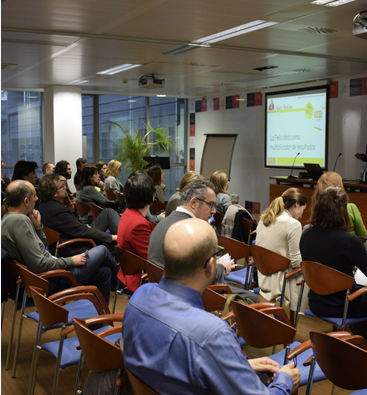1. Como auxiliar Como auxiliar el verbo to be se usa:
a) Para formar los tiempos «continuos» acompañando a la
«forma en -ing» del verbo que se conjuga: He is working Está trabajando
We are playing Estamos jugando
b) Para formar la voz pasiva acompañando al participio pasado del verbo que se conjuga:
He is loved Es amado
They are hated Son odiados
c) Para respuestas cortas, «preguntas coletilla», para reemplazar a otro verbo y para las formas enfáticas: Respuesta corta: "Is he working?" "Yes, he is" "¿Está trabajando?" "Sí, lo está"
«Pregunta coletilla»:
He was drinking, wasn’t he? Estaba bebiendo, ¿verdad?
Reemplazar a un verbo usado con anterioridad, evitando su repetición:
He was drinking, but she wasn’t Él estaba bebiendo, pero ella no
Forma enfática:
But she was drinking, too Pero ella estaba bebiendo también (Se pronuncia resaltando
ligeramente el auxiliar was)
2. Como cópula o enlace entre el sujeto y el atributo (v. 18.2, tipol): He is young Es joven
He is in London Está en Londres
3. Con la palabra there, con el significado de «haber»: there is/there’s hay (en singular)
there are hay (en plural)
there was había (en singular)
there were había (en plural)
there has been ha habido (en singular)
there have been ha habido (en plural)
there had been había habido (en singular y plural)
there will be habrá (en singular y plural)
there would be habría (en singular y plural)
La interrogación se forma invirtiendo el orden sujeto-verbo, y la negación, con not
Is there?/are there? ¿Hay?
There isn’t/there aren’t No hay
There hasn’t/haven’t been No ha habido
There won’t be No habrá
There wouldn’t be No habría
El verbo concierta en número con el nombre correspondiente: There’s a man in the street Hay un hombre en la calle There are some men in the street Hay algunos hombres en la calle
Sin embargo, there's se usa a menudo con un nombre plural en lenguaje coloquial (v. tamb. 7.4.3):
There’s some letters Hay unas cartas
for you to sign que tienes que firmar
4. To be to puede tener los siguientes valores:
a) Planes, preparativos, intención de hacer algo:
They are to be married Se casarán/se van a casar next week la semana que viene
En los titulares de periódicos suele omitirse to be:
The Prime Minister El primer ministro visitará
to visit Welsh coal mines las minas de carbón de Gales
b) Órdenes o prohibiciones indirectas, con la traducción de
«haber de» o «tener que:
We are to meet him at Tenemos que ir a esperarlo a la
the station estación (alguien así lo ha dispuesto)
You are not to smoke here No se puede fumar aquí
c) Futuro hipotético:
If you are to become a lawyer... Si has de ser abogado... If he were to come today, Si viniera hoy,
he wouldn’t find me here no me encontraría aquí
d) Posibilidad/imposibilidad:
They are to be found Se encuentran por todo el país all over the country He’s not to be found anywhere No se
encuentra por ninguna parte
e) Destino, fatalidad (generalmente en pasado):
His brothe was to lose his life Su hermano habría de perder la vida
in a car crash, too también en un accidente de coche
5. Como verbo léxico, con el significado de «existir» (poco frecuente):
God is Dios existe
6. En modismos: to be about to/
to be on the point of to be cold/hot to be hungry/thirsty/sleepy to be in a hurry to be late to be right/wrong
estar a punto de
tener/hacer frío/calor tener hambre/sed/sueño tener prisa
llegartarde
tener razón/estar equivocado
Dentro de los modismos con to be podemos incluir la edad y las horas:
• Edad
El verbo to be se emplea para expresar la edad:
How old are you? ¿Qué edad tienes/cuántos años tienes?
I’m twenty (years old) Tengo veinte años
• Horas El verbo to be se emplea igualmente para expresar las horas: What time is it?/what’s the time? ¿Qué hora es? It’s one/two/three, etc., o’clock
Es/son la(s) una/dos/tres, etc.
It’s half past four/five, etc. It’s
(a) quarter to/past six/ seven, etc. It’s
five/ten, etc., to/
past eight/nine, etc. It’s nine/twelve, etc., minutes
to/past five
Son las 4/5, etc., y media
Son las 6/7, etc., menos/y cuarto
Son las 8/9, etc., menos/y cinco/diez, etc.
Son las cinco menos/y nueve/doce minutos, etc. (suele añadirse la palabra minutes para cualquier número de
minutos que no sea cinco, diez, veinte o veinticinco)
En inglés americano suele usarse oflafter en lugar de tolpast. It’s twenty of six Son las seis menos veinte It’s twenty-five after eight Son las ocho y veinticinco








